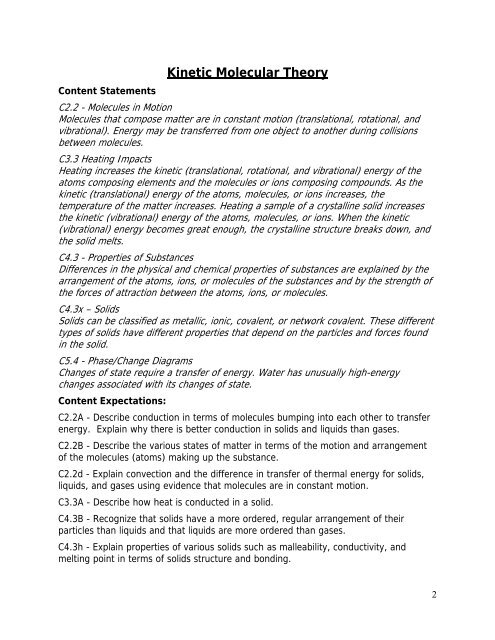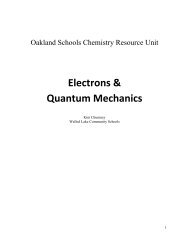Phase changes of water - Oakland Schools
Phase changes of water - Oakland Schools
Phase changes of water - Oakland Schools
Create successful ePaper yourself
Turn your PDF publications into a flip-book with our unique Google optimized e-Paper software.
Content Statements<br />
Kinetic Molecular Theory<br />
C2.2 - Molecules in Motion<br />
Molecules that compose matter are in constant motion (translational, rotational, and<br />
vibrational). Energy may be transferred from one object to another during collisions<br />
between molecules.<br />
C3.3 Heating Impacts<br />
Heating increases the kinetic (translational, rotational, and vibrational) energy <strong>of</strong> the<br />
atoms composing elements and the molecules or ions composing compounds. As the<br />
kinetic (translational) energy <strong>of</strong> the atoms, molecules, or ions increases, the<br />
temperature <strong>of</strong> the matter increases. Heating a sample <strong>of</strong> a crystalline solid increases<br />
the kinetic (vibrational) energy <strong>of</strong> the atoms, molecules, or ions. When the kinetic<br />
(vibrational) energy becomes great enough, the crystalline structure breaks down, and<br />
the solid melts.<br />
C4.3 - Properties <strong>of</strong> Substances<br />
Differences in the physical and chemical properties <strong>of</strong> substances are explained by the<br />
arrangement <strong>of</strong> the atoms, ions, or molecules <strong>of</strong> the substances and by the strength <strong>of</strong><br />
the forces <strong>of</strong> attraction between the atoms, ions, or molecules.<br />
C4.3x – Solids<br />
Solids can be classified as metallic, ionic, covalent, or network covalent. These different<br />
types <strong>of</strong> solids have different properties that depend on the particles and forces found<br />
in the solid.<br />
C5.4 - <strong>Phase</strong>/Change Diagrams<br />
Changes <strong>of</strong> state require a transfer <strong>of</strong> energy. Water has unusually high-energy<br />
<strong>changes</strong> associated with its <strong>changes</strong> <strong>of</strong> state.<br />
Content Expectations:<br />
C2.2A - Describe conduction in terms <strong>of</strong> molecules bumping into each other to transfer<br />
energy. Explain why there is better conduction in solids and liquids than gases.<br />
C2.2B - Describe the various states <strong>of</strong> matter in terms <strong>of</strong> the motion and arrangement<br />
<strong>of</strong> the molecules (atoms) making up the substance.<br />
C2.2d - Explain convection and the difference in transfer <strong>of</strong> thermal energy for solids,<br />
liquids, and gases using evidence that molecules are in constant motion.<br />
C3.3A - Describe how heat is conducted in a solid.<br />
C4.3B - Recognize that solids have a more ordered, regular arrangement <strong>of</strong> their<br />
particles than liquids and that liquids are more ordered than gases.<br />
C4.3h - Explain properties <strong>of</strong> various solids such as malleability, conductivity, and<br />
melting point in terms <strong>of</strong> solids structure and bonding.<br />
2
















